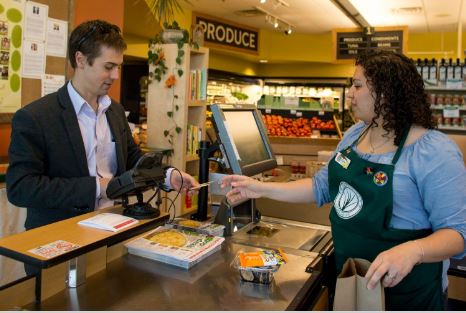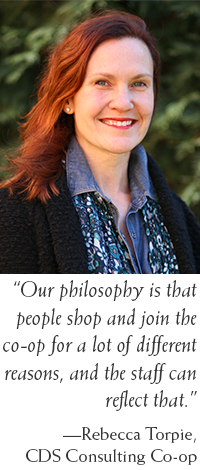
Customer service experiences are a very hot topic, especially online and in social media. People regularly share the good and the bad, and social media has become the new word-of-mouth. It’s where people hear from friends, family and acquaintances how they “rate” the businesses they frequent. The Amazon acquisition of Whole Foods has upped the ante on how customer service for groceries is going to be received and defined, especially because its delivery is rooted in online platforms. Like any marketplace game-changer, this provides an opportunity and a customer service challenge for retailers.
For food co-ops, being able to articulate how they do business differently in ways that support people and communities is paramount. Food co-ops are important community assets, offering an alternative to a corporate behemoth determined to reinvent ways to monopolize the marketplace—which is often a formula for maltreatment of people involved in most of the food chain. Treating people well is understandably good, yet sustaining their interest and investment as shoppers and owners of the co-op is the key to a sustainable future.
Cultivating a good understanding of the cooperative difference—as service providers and community leaders—is how food co-ops will remain relevant. That’s why the CDS Consulting Co-op, in conjunction with the Power of Participation (POP) Program, has created a Cooperative Service training program to address the specific needs of food cooperatives. Many training programs focus on skills for how to treat people well, and that’s all good, but they don’t address how food co-ops need to approach providing service. Cooperatives are owned by the people who use them. Understanding their needs and motivations, as well as anticipating how future shoppers and owners will engage with the co-op is a big part of the customer service equation.
 Brittany Baird, operational and financial improvement consultant has been offering Cooperative Service training to clients that want their education efforts to go beyond standard customer service. She talked about why this distinct approach to customer service training is so important. “There has not been a standard training for co-op-specific customer service. Ownership is a point of differentiation, but it’s left out of a lot of training. People often don’t get the techniques and skills they need to be fluid and confident talking about the co-op.”
Brittany Baird, operational and financial improvement consultant has been offering Cooperative Service training to clients that want their education efforts to go beyond standard customer service. She talked about why this distinct approach to customer service training is so important. “There has not been a standard training for co-op-specific customer service. Ownership is a point of differentiation, but it’s left out of a lot of training. People often don’t get the techniques and skills they need to be fluid and confident talking about the co-op.”
A lot of times the task of recruitment and customer engagement falls on the front-end department, which is natural because it is where people pay for their groceries. However, Baird has noticed that other store departments often don’t know what to say or do when asked about joining the co-op, and there is an unnecessary gap in knowledge. This is a missed opportunity not only to meet the needs of the customer, but to help create alignment and build co-op culture within the organization. “The fragmentation is detrimental to the cooperative identity in the organization,” Baird said. “Often in the hiring process new employees are ready to be engaged, but they don’t get to see the big picture.”
Baird said the Cooperative Service training emphasizes personal connections to the co-op. “We talk a lot about the co-op’s mission, principles and values in ways that people can connect to it. We ask them what their connection is and why it’s important to them. It’s a unique approach.” She thinks that a big part of this relationship is seeing how the co-op is connected to the community and its members. “I’ve done this training and there were people there who didn’t know that their co-op is community-owned.”
She also emphasized that Cooperative Service is not just ‘thank you come again.’ Baird encourages people to go a lot deeper, and to be authentic. There are the traditional goals of customer service versus the co-op’s goals. “We ask people how they can make more meaningful connections. I think the two most impactful things are the different ways people connect to the co-op’s mission, and finding your personal story in that.”
Overall, Baird said the training focuses on developing staff confidence. “It’s so important to every service interaction. We often assume people are a “natural” at it or not, but these are teachable, trainable skills. People in co-ops especially need skills for inviting participation.”
Rebecca Torpie, POP consultant and Cooperative Service trainer said, “Our co-ops have to focus on training like this right now. It’s our differentiation. We may never compete on price, but Whole Foods will never have member-owners.” In the training, staff are asked to answer these questions:
- What does your customer service do to further the co-op’s goals?
- How does what you do create community?
- How do you connect people to ownership at the co-op?

“Our philosophy is that people shop and join the co-op for a lot of different reasons, and the staff can reflect that, like talking about why they joined the co-op, or why they work there. It’s a way to invite people into the co-op,” Torpie said. We discuss Marilyn Scholl’s Hierarchy of Participation to show that people approach membership in different ways—some for products, some for belonging and others for the impact the co-op makes. The training includes role playing different scenarios and how to discuss membership to meet people where they are on the continuum of involvement.
Baird and Torpie agree that this important work also needs to be supported by good operational systems. “The conventional operators have stepped up their game in terms of customer service, so we have a continued challenge to create systems that back up the co-op’s relationship-based approach to customer service,” Torpie said.
These systems include having solid member sign-up procedures in place, using tools for consistently approaching and educating customers, and implementing good onboarding for new staff and regular trainings for all staff. “Leadership has to have a clear vision for what defines great co-op customer service.”
“Our goal is to support the systems that facilitate good organizational culture,” Baird said. “Once it’s part of the lexicon, people understand what’s being asked of them.”
Have more questions?
Get in touch with one of our consultants.
